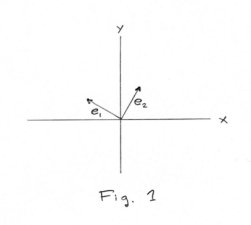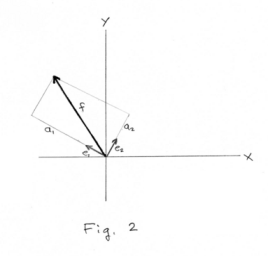Website owner: James Miller
Expansion by orthogonal systems of functions in Hilbert space. Complete orthogonal systems. Orthonormal systems. Generalized Fourier series, coefficients. Parseval’s identity.
Def. Orthogonal system. A system of functions
![]()
is called orthogonal if every function is orthogonal to every other function i.e. if

Examples of orthogonal systems.
1. The sequence of trigonometric functions
1, cos x, sin x, cos 2x, sin 2x, .... , cos nx, sin nx, .....
on the interval (-π, π). This system is one of the first and most important examples of orthogonal systems, appearing in works of Euler, D. Bernoulli, and d’Alembert in connection with problems on oscillation of strings. The study of it has played an essential role in the development of analysis.
2. The sequence of Legendre polynomials

on the interval (-1, 1). The first few polynomials of the sequence are

Def. Orthonormal system. A system of functions
![]()
is called orthonormal if it is orthogonal and if each of the functions is of unit length i.e.
![]()
Example. The sequence of trigonometric functions

on the interval (-π, π) is orthonormal. These functions are obtained by dividing the functions
1, cos x, sin x, cos 2x, sin 2x, .... , cos nx, sin nx, .....
by their lengths.

Expansion by orthogonal systems of functions. Let e1 and e2 be any two mutually perpendicular vectors of unit length in the plane. See Fig. 1. Then any vector f in the plane can decomposed in the direction of these two vectors and written as
f = a1e1 + a2e2

where a1 = f•e1 and a2 = f•e2 as shown in Fig. 2. Similarly if e1, e2 and e3 are any three mutually perpendicular unit vectors in three-dimensional space any vector f in space can be decomposed in the direction of these three vectors and written as
f = a1e1 + a2e2 + a3e3
where a1 = f•e1, a2 = f•e2 and a3 = f•e3 .
Just as it is possible to represent any vector f in three-dimensional space as a linear combination
f = a1e1 + a2e2 + a3e3
of three pairwise orthogonal unit vectors it is possible to represent any function f in Hilbert space as a linear combination of an orthonormal system of functions. For this to be so, however, it is necessary for the orthonormal system to be complete.
Def. Complete orthogonal system. An orthogonal system of functions is called complete if it is impossible to add to it even one function, not identically equal to zero, that is orthogonal to all the functions of the system.
It is easy to give an example of an orthogonal system that is not complete. If we are given any arbitrary orthogonal system and remove a single function from it, the remaining system will be incomplete. Suppose, for example, that we remove cos x from orthogonal system
1, cos x, sin x, cos 2x, sin 2x, .... , cos nx, sin nx, .....
The remaining system
1, sin x, cos 2x, sin 2x, .... , cos nx, sin nx, .....
is orthogonal as before, but it is not complete since the function cos x which we excluded is orthogonal to all functions of the system.
Theorem 1. Let a complete orthonormal system of functions in Hilbert space
![]()
be given. Then every function f(x) in the space can be represented by a series
![]()
where the coefficients an of the expansion are equal to the projections of the vector f on the elements of the normal orthogonal system i.e.
![]()
Because of the analogy with Fourier series 1) is sometimes called a generalized Fourier series and the coefficients an generalized Fourier coefficients.
The formula above for an is easily derived. If we multiply both sides of 1) scalarly by any function fn of the system, we get
![]()
Because fm∙fn = 0 for m ≠ n and fn∙fn = 1, equation 2) reduces to
![]()
Theorem 2 (Parseval’s identity). The square of the length of a vector in Hilbert space is equal to the sum of the squares of its projections onto a complete system of mutually orthogonal directions. In other words, if
![]()
are a complete orthonormal system of functions in Hilbert space and if a function f is given by
![]()
then

Condition of completeness. The condition of completeness for a functional space is that 3) hold for an arbitrary function of the space.
Analogue of the concept of completeness in n-dimensional space. In n-dimensional space any vector in the space can be expressed as a linear combination of n linearly independent basis vectors. However, not every vector in the space can be expressed as a linearly combination of only n-1 of the basis vectors. If one of the basis vectors is missing, not all vectors in the space can be expressed as a linear combination of the remaining basis vectors. The condition of completeness of an orthogonal system of functions corresponds to the requirement for a full set of n basis vectors for an n-dimensional space.
References
Mathematics, Its Content, Methods and Meaning. Vol. 3, Chap. XIX
Jesus Christ and His Teachings
Way of enlightenment, wisdom, and understanding
America, a corrupt, depraved, shameless country
On integrity and the lack of it
The test of a person's Christianity is what he is
Ninety five percent of the problems that most people have come from personal foolishness
Liberalism, socialism and the modern welfare state
The desire to harm, a motivation for conduct
On Self-sufficient Country Living, Homesteading
Topically Arranged Proverbs, Precepts, Quotations. Common Sayings. Poor Richard's Almanac.
Theory on the Formation of Character
People are like radio tuners --- they pick out and listen to one wavelength and ignore the rest
Cause of Character Traits --- According to Aristotle
We are what we eat --- living under the discipline of a diet
Avoiding problems and trouble in life
Role of habit in formation of character
Personal attributes of the true Christian
What determines a person's character?
Love of God and love of virtue are closely united
Intellectual disparities among people and the power in good habits
Tools of Satan. Tactics and Tricks used by the Devil.
The Natural Way -- The Unnatural Way
Wisdom, Reason and Virtue are closely related
Knowledge is one thing, wisdom is another
My views on Christianity in America
The most important thing in life is understanding
We are all examples --- for good or for bad
Television --- spiritual poison
The Prime Mover that decides "What We Are"
Where do our outlooks, attitudes and values come from?
Sin is serious business. The punishment for it is real. Hell is real.
Self-imposed discipline and regimentation
Achieving happiness in life --- a matter of the right strategies
Self-control, self-restraint, self-discipline basic to so much in life